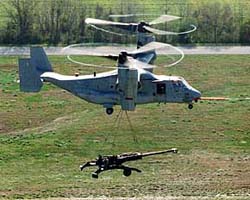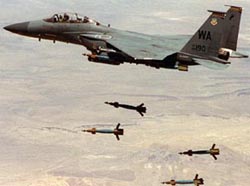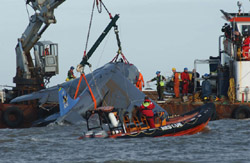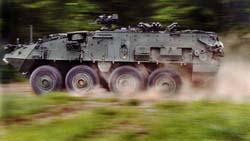Page 1
Daily News
By Gail Helmer
| Send Us News | Archives | Main |
Thursday August 15, 2002
PC News
- Splinter Cell Movie Trailer
- New Screens: Prisoner of War
- Medieval: Total War Goes Gold
- Successful Test P3I Bat Submunition
- Detachment Activated To Support V-22 Testing
- Lockheed Martin Meets Air Force Laser Guided Bomb Requirements
- Harrier Successfully Salvaged From Sea
- Strykers Redeploy On New High-Speed Vessel
Splinter Cell Movie Trailer
Get an exclusive sneak peak into Ubi Soft's upcoming stealth action game, Splinter Cell in this movie trailer. The latest creation inspired by the works of Tom Clancy, Splinter Cell is a third person stealth action game, featuring cyber-terrorism, shadow agencies, and covert operations and is set in the realistic, highly detailed geopolitical universe.
Splinter Cell will grant players access to the highest echelons of national security, where shadowy operatives have the freedom to do whatever it takes to safeguard America. In Splinter Cell, the player controls Sam Fisher, a field operative of a secretive "black-ops" NSA sub-agency called Third Echelon. Sam Fisher is geared up to infiltrate high-security strongholds, seize critical intelligence, destroy threatening data and neutralize the enemy - all without leaving a trace. Release Date: Fall 2002.
New Screens: Prisoner of War
Codemasters has released more screens from its upcoming WWII third-person stealthy action adventure by Wide Games. The game is set to launch on PC CD-ROM on September 20th. Launched last month on PlayStation 2 and Xbox, Prisoner of War has become a massive success. It has recently achieved best individual format chart placings at No.3 on the PS2 chart and No.2 on the Xbox chart.
While many may have dismissed Wide Gamesí concept for Prisoner of War, Codemastersí belief in its possibilities for delivering a new style of gameplay to the market has been hugely rewarded. Itís an original, non-violent game set in a historic war context, played in confined areas with hyper-alert guards and one where as players have no opportunity to arm themselves with weapons. For more information on Prisoner of War, check out our previous coverage of the game.
Medieval: Total War Goes Gold
Activision and The Creative Assembly announce today that Medieval: Total War, the sequel to Shogun: Total War, has gone gold and is on its way to manufacturing. Players vie for control of Europe through epic battles of conquest that span more than 400 years of savage medieval combat.
Medieval: Total War allows players to take control of one of 12 European powers as they attempt to rewrite history through a mixture of epic battles, trade, diplomacy and resource management. Featuring an incredibly powerful 3D engine, the game supports real-time 3D battles of more than 10,000 troops and more than 100 unique unit types, including knights, infantry and siege engines, in terrain as varied as deserts, forest, plains and mountains. Players will utilize authentic battle strategies and tactics as they unleash their forces against medieval castles and mighty fortresses with an arsenal of battle-field weapons including long-bows, muskets, cannons and catapults which can pound castle walls and buildings to rubble.
Military News
Successful Test P3I Bat Submunition
The U.S. Army and Northrop Grumman Corporation's Land Combat Systems business unit have announced the successful deployment of a recoverable Pre-Planned Product Improved (P3I) Bat submunition at White Sands Missile Range, N.M.
This third of three successful flight tests conducted to date involving recoverable Bats was performed by the Army's Precision Fires Rocket and Missile Systems project office and Northrop Grumman to demonstrate the performance of the P3I Bat's dual-mode seeker against a number of benign stationary targets using the sensor's lookdown search mode.
"Preliminary postflight data analysis indicates that the P3I Bat achieved the key objectives of the test mission," said Emmitt Gibson, vice president of Precision Munitions at Northrop Grumman. "The submunition's dual-mode seeker successfully performed a stationary target attack flight profile, which put the expected number of targets clearly in the seeker's field of view. The Bat was also successful in demonstrating the navigation accuracy required for stationary target detection."
For the test, the Bat submunition was dispensed at a nominal tactical altitude from a Cessna aircraft. At the conclusion of the test mission, the recoverable Bat landed vertically on its tail spikes, as designed, with no damage to the dual-mode seeker. The seeker was immediately recovered for reuse on future flight tests.
Gibson acknowledged that several anomalies, most of which were minor in nature, were identified during the postflight data analysis. However, he said he expects that all of the anomalies, including one related to search ground acquisition algorithms, will be satisfactorily resolved before the next stationary target test set for mid-August at Eglin Air Force Base, Fla.
Currently in low-rate initial production under contract to the Army at Redstone Arsenal, Ala., Bat is an autonomous submunition that uses a combination of passive acoustic and infrared sensors to seek, identify and destroy moving armored targets deep in enemy territory. After being dispensed from the Army Tactical Missile System Block II, the Bats deploy their aerodynamic surfaces, acoustically acquiring moving targets and maneuvering to the target area.
The P3I Bat, a planned block upgrade, adds advanced millimeter-wave radar and improved imaging IR sensors, providing a co-boresighted, dual-mode RF/IR seeker that works with the baseline acoustic sensors. The new seeker will expand Bat's engagement capability to include a wide range of both stationary and moving targets, particularly missile launchers. It will also improve Bat's performance in adverse weather conditions and against sophisticated countermeasures.
Detachment Activated To Support V-22 Testing
A new detachment was activated here recently to support V-22 Osprey testing. Detachment 2 was created to operationally test the MV-22 from the special operations perspective to assess its value as a baseline for the special operations variant, the CV-22.
"I'm proud to be part of the outstanding team the Air Force and Marine Corps have created to conduct operational test of the MV-22," said Maj. Gary McCollum, Det. 2 commander. "Our focus is and will remain viewing the V-22 through the eyes of the future generations of Marines and special operations forces warriors who will take the Osprey into harm's way in support of our national objectives. We owe it to them never to lose sight of the fact the V-22 is a combat aircraft, and to do everything we can to develop and take advantage of its unique capabilities in support of their mission."
Det. 2 comprises the Air Force part of the V-22 Multiservice Operational Test Team, which includes the 10 Air Force people in Det. 2, one Air Force Operational Test and Evaluation Center test director, and 18 Marine operators and maintainers.
McCollum said the detachment aircrew and maintainers are working with the V-22 Integrated Test Team here to make observations that will help them with assessments and evaluations during the dedicated operational test periods, which could begin next summer.
"We will operate and maintain our aircraft in an operationally representative environment," McCollum said. "We'll fly and maintain the V-22 in conditions which are as close as we can reasonably make them to what an operational squadron would encounter on a day-to-day basis. Our flights will be based on representative Marine and (special operations forces) missions."
Later on, the larger version of the MOTT, which includes Detachment 2, will conduct the second phase of the V-22's operational evaluation using MV-22 Block A production aircraft from various ship and shore locations throughout the United States.
Det. 2 falls under the 18th Flight Test Squadron at Hurlburt Field, Fla. The squadron functions as the operational test agency for Air Force Special Operations Command. (Courtesy of AFSOC News Service)
Lockheed Martin Meets Air Force Laser Guided Bomb Requirements
The U.S. Air Force has advised Lockheed Martin that the company now is fully qualified to build Paveway II GBU-10 and GBU-12 Laser Guided Bomb (LGB) kits. The announcement followed 50 required flight test drops from March through June at the U.S. Navy's China Lake facility in California.
"Lockheed Martin's qualification to produce LGBs culminates a two-year team effort with the U.S. Air Force and U.S. Navy to create a qualified second source for this critical weapon system," said Maj. Steve Toth, Paveway II program manager at Hill AFB, where procurement decisions about these precision-guided munitions are made. Laser Guided Bombs have been used extensively in the war against terrorism.
Lockheed Martin currently is producing GBU-16 kits for the U.S. Navy. With the USAF qualification for GBU-10 and 12 kits, Lockheed Martin is qualified to produce all three variants of the Paveway II line. The Archbald facility, where the kits are made, delivered the first production kits in February 2002. Production on the Navy requirements continues through July 2003.
Air Force qualification flight tests were performed by F-15, F-16, A-10, F-117 aircraft and Navy F-18 Hornets, according to Maj. Toth. While China Lake was used as the range facility, nearby Edwards AFB and the Lockheed Martin Aeronautics facility in Palmdale supplied aircraft and pilots, plus mission planning, bomb "buildup" and other essential support.
Each guidance kit consists of a Computer Control Group, which is the front-end guidance system, plus an Air Foil Group, which includes the flight stability fins on the back of each Paveway II LGB.
"The kits significantly improve the accuracy of gravity weapons - often referred to as 'dumb bombs' - thereby reducing collateral damage and risks to U.S. and allied ground forces," Maj. Toth said. "Paveway GBU-16 kits are used on 1,000-lb. bombs, while GBU-10 and GBU-12 kits are used on 2,000-lb. and 500-lb. bombs respectively."
Completion of the Air Force qualification allows Lockheed Martin to pursue the international market for LGBs and Laser Guided Training Rounds (LGTRs) as the only supplier of both training and tactical laser guided systems. The Archbald business successfully developed and fielded LGTRs beginning in 1992. Since then, the Archbald plant has produced almost 25,000 units for the U.S. Navy and other customers in seven countries.
Harrier Successfully Salvaged From Sea
An RAF Harrier that crashed into the sea off Lowestoft was successfully salvaged on 8 August 2002.
The Harrier came to grief whilst in a low hover over the water at the conclusion of a display at the Lowestoft airshow on 2 August. The aircraft's pilot, Flight Lieutenant Tony Cann, from No 20 (Reserve) Squadron, the Harrier training unit at RAF Wittering, suffered minor injuries after ejecting from the stricken aircraft seconds before hitting the water. No spectators were injured.
The aircraft came to rest in relatively shallow water, and a salvage barge managed to winch the aircraft aboard on the evening of 8 August. The cause of the accident is the subject of an RAF investigation, but indications are of an engine failure. The aircraft will now undergo a full engineering assessment to establish the extent of the damage it has suffered.
Strykers Redeploy On New High-Speed Vessel
The Army's future force met what some believe is the future of Army transportation when elements of a Stryker Brigade Combat Team were transported up the west coast this week on a new high-speed vessel.
The HSV-X1 Joint Venture, a giant wave-piercing catamaran, transported soldiers, Stryker armored vehicles and equipment from California to Tacoma, Wash.
The Stryker task force had just finished its participation in Millennium Challenge 02 and the Army Transformation Experiment at Fort Irwin's National Training Center.
The Strykers were loaded onto the high-speed vessel at Port Hueneme, Calif., Aug. 11, and they arrived back at Fort Lewis, Wash., Aug. 13.
The Army leased the Joint Venture last year to assess the capabilities of this type of technology for future procurement, officials said.
This was the Army's first demonstration of the high-speed vessel's ability to transport complete packages of combat-ready soldiers with their equipment, Transportation Corps officials reported.
The ability to transport units intact will greatly reduce the need for large-scale on-shore reception, staging, onward movement and integration of soldiers, vehicles and equipment, said Chief Warrant Officer 4 Mike Wichterman, operations officer, 7th Transportation Group. Reducing the logistics footprint is paramount as the Army transforms to a faster, stronger, more lethal force, he said.
"For each fighter in the force today, we have a combat service support soldier making sure he's got the beans, bullets, water and fuel needed to carry on the fight," Wichterman said. "The objective theater support vessel will give us a much broader package of dominant maneuver, allowing us to transport the combat unit sets as a complete package. We'll be able to insert them without the need for a large combat service support soldier package to assist on the shore executing reception, staging, and onward movement."
The objective vessel will also have a state-of-the-art C4ISR suite (command, control, communications, computers, intelligence, surveillance and reconnaissance suite) on board, giving commanders the ability to obtain real-time information to plan and rehearse the mission while underway, he added.
"Commanders will be able to maintain situational awareness with their higher headquarters, receiving the same intelligence updates, changes to the operational plan and supporting information," he said. "They can make major changes to the plans while en route to their destination, and be more effective, more lethal in the process."
In October, the Army leased the Joint Venture, a commercial ferry modified for the military, to assess the capability of high-speed vessels to meet the need for faster, more maneuverable watercraft with shallow draft and large cargo capacity.
The Navy, Marine Corps and Coast Guard are also testing similar vessels for service specific missions.
The 313-foot aluminum catamaran is capable of traveling at speeds greater than 40 knots. It can carry 850 short tons and accommodate 363 personnel, including crew. It is approximately four times faster than vessels currently in the Army watercraft fleet, Wichterman said.
Since April, the vessel has been used to move equipment and personnel in the Persian Gulf in support of Operation Enduring Freedom.
"That was an excellent opportunity for the Army to test the capabilities of high-speed watercraft," said Chief Warrant Officer Billy Davis, the Army skipper of the vessel. "We put the vessel through its paces and were able to gather data in an actual operational environment."
Army combat developers will use the data gathered during the year-long lease period to define the requirements for Theater Support Vessels, the Army's objective high-speed vessels, said Chief Warrant Officer 4 Scott Aimi, Combat Developer assigned to the Combined Arms Support Command, Directorate for Combat Developments for Transportation, Fort Lee, Va. His organization assesses everything from the propulsion system to crew accommodations.
"Our recommendations can be as simple as adding more personal storage space for the crew or changing the deck covering so it's less slippery," Aimi said. "However, a major addition to future vessels will be cargo roller system like that on the C-17. The system will facilitate the Army's next step in seamless distribution - the capability to handle pre-formed and interchangeable packaging, pallets, containers which are compatible with modern load handling systems on military vehicles."
The future Theater Support Vessels will transport units in hours instead of days, said the Army's chief of transportation, Maj. Gen. Robert T. Dail.
Faster watercraft promise greater payload throughput, as well as the ability for combatant commanders to rapidly reposition and mass assets within a theater of operations, Dail said.
"Shallower draft and greater maneuverability will allow a commander to use austere or degraded ports and bypass predictable choke points, diminishing asymmetrical advantages held by an enemy," Dail said.
"The ability to choose the time and place to quickly initiate action and deliver a complete package of soldiers, equipment, fully fueled and with ammunition will allow a combatant commander to gain and maintain operational momentum and positional advantage over an adversary," he said.
| Send Us News | Archives | Main |




